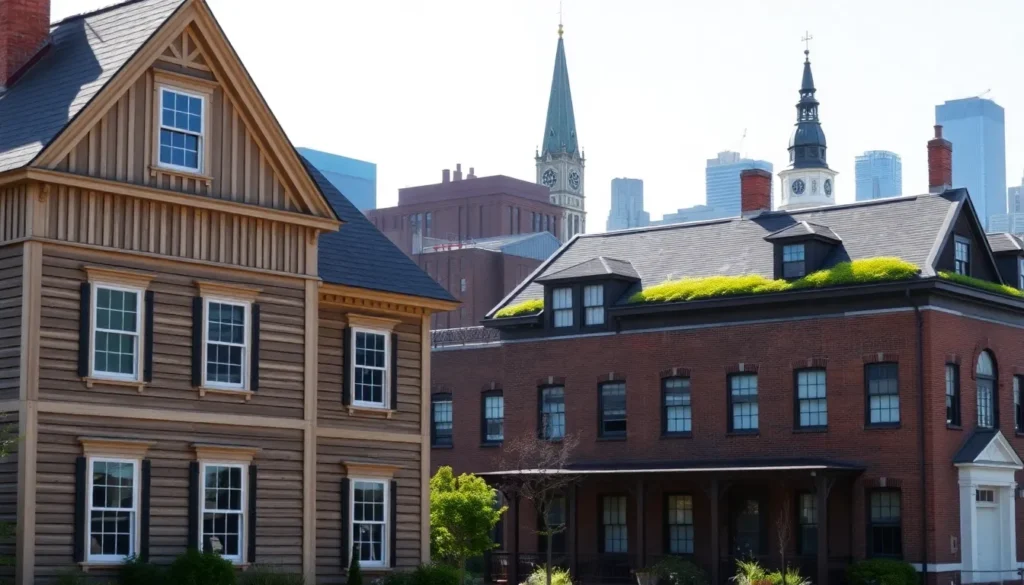Table of Contents
ToggleRoman architecture isn’t just a bunch of old stones; it’s a testament to human ingenuity that’s stood the test of time. Picture this: massive structures that once housed gladiators, emperors, and everyday citizens, all designed with precision and flair. From the iconic Colosseum to the majestic Pantheon, these architectural wonders showcase an era where building something that could last was the ultimate flex.
Overview of Roman Architecture
Roman architecture stands as a masterclass in engineering and aesthetic innovation. Key characteristics include the use of arches, vaults, and domes, which allowed for expansive and durable structures. The Roman environment heavily influenced design, serving practical needs while showcasing power.
Materials like concrete, brick, and stone defined Roman construction. Strong foundations supported massive buildings. Public structures like temples and forums often featured elaborate facades, emphasizing grandeur and accessibility for citizens.
Notable examples include the Colosseum, a marvel of design, accommodating thousands for public events. Its unique combination of columns and arches exemplifies Roman ingenuity. The Pantheon, another iconic structure, features a coffered dome and an oculus, which remains unmatched in scale and harmony.
Roman architecture also prioritized urban planning. Think of cities designed with efficient layouts, featuring grids and central forums. Roads facilitated trade and movement, connecting distant regions to Rome.
Architects and engineers played vital roles in advancing techniques. They utilized practical methods for construction while considering aesthetics. These innovations inspired future generations, influencing the Renaissance and neoclassical movements.
Roman architecture symbolized not just power but also civic identity. It reflected the Empire’s values, merging form and function seamlessly. By understanding this architectural heritage, one gains insight into the societal pillars that supported Roman civilization.
Key Characteristics of Roman Architecture


Roman architecture showcases unique traits that set it apart from other styles. The emphasis on functionality, durability, and aesthetics marks the legacy of this architectural marvel.
Use of Arches and Vaults
Arches played a pivotal role in Roman architecture. Builders utilized arches to support expansive structures and distribute weight efficiently. Vaults extended these principles, enabling the creation of large interior spaces. The skillful use of these elements allowed for grandiose structures like the Colosseum, which astonished spectators with its scale. Architects designed these features not only for structural integrity but also for aesthetic appeal. Domes, exemplified by the Pantheon, highlight the mastery of vault construction, combining beauty and practicality in a single framework.
Innovations in Construction Materials
Roman builders revolutionized construction with new materials. Concrete emerged as a primary building component, providing strength and durability. Its versatility facilitated the construction of intricate forms and vast structures. Brick and stone complemented concrete, enhancing the overall aesthetics and longevity of buildings. Such innovations allowed for ambitious architectural endeavors, including massive aqueducts and public baths. These materials reflected the Roman commitment to engineering mastery and artistic expression. The combination of these elements established a foundation that influenced architectural practices for centuries.
Famous Roman Architectural Sites
Roman architecture is exemplified through remarkable sites that showcase engineering brilliance and aesthetic innovation. Three notable examples include the Colosseum, the Pantheon, and the aqueducts.
The Colosseum
The Colosseum stands as an iconic symbol of Roman engineering. With a capacity of approximately 50,000 spectators, it hosted gladiatorial contests and public spectacles. Arches dominate its design, enabling the massive structure’s stability and aesthetic appeal. Constructed between AD 70 and 80, the amphitheater showcases a complex system of vaults that enhance its grandeur. This architectural marvel illustrates Rome’s social culture and its commitment to public entertainment, reinforcing connections within the community.
The Pantheon
The Pantheon represents a pinnacle of Roman architecture and engineering. Built around AD 126, its coffered dome remains the largest unreinforced concrete dome in the world. An oculus at the dome’s center provides natural light, illuminating the interior and symbolizing the connection between the earthly and divine. The portico displays an array of Corinthian columns, contributing to its majestic appearance. Visitors are often struck by the harmony of design and function, which has influenced countless structures across history.
Aqueducts
Aqueducts showcase Roman ingenuity in water management. These remarkable structures transported water over long distances, utilizing gravity for efficient flow. Numerous aqueducts, such as the Aqua Appia and Aqua Claudia, served Rome and its surroundings. Constructed with stone and concrete, these elevated bridges often feature impressive arches, blending functionality with visual grandeur. The aqueducts played a critical role in public health by supplying reliable freshwater, reflecting the Romans’ commitment to infrastructure and urban living.
Influence on Modern Architecture
Roman architecture significantly shaped modern architectural practices. The use of concrete, pioneered by Roman engineers, remains a staple in contemporary construction. Innovations in arches and vaults allowed for expansive designs, influencing modern stadiums and bridges. These elements have become essential in creating open, functional spaces.
Prominent features such as domes directly trace their lineage to structures like the Pantheon. Many modern buildings incorporate dome-like forms, showcasing the durability and grandeur of this design. Courthouses and museums often replicate classical elements, reflecting a desire for permanence and authority.
Urban planning principles from ancient Rome manifest in today’s city designs. The grid layout and the consideration for public spaces inform how modern cities manage flow and accessibility. Central parks and plazas echo the Roman forum’s role in community engagement.
Sustainable design, too, draws inspiration from Roman infrastructure. Aqueducts exemplified efficient water management systems, a concept revisited in eco-friendly urban solutions. Contemporary buildings aim to integrate sustainable practices, often seeking harmony with the environment, much like ancient Roman structures.
Preservation efforts and adaptive reuse of Roman buildings underline their enduring legacy. Many structures, including the Colosseum, continue to inspire architects today. The grandeur and functionality of Roman designs serve as a benchmark for modern architecture, emphasizing a blend of aesthetics and practicality that exists in countless buildings around the world.


